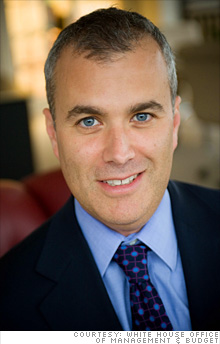NEW YORK (Fortune) -- Efficient. Effective. Goal-oriented.
Not exactly the words most Americans would use to describe their federal government these days.
 |
| Jeff Zients, chief performance officer |
Indeed, a recent Gallup poll showed Americans think the federal government wastes on average 50 cents of every dollar it gets. The budget deficit balloons, and President Barack Obama is under mounting pressure to squeeze more out of taxpayer dollars to jumpstart the economy.
Sounds like a job for a professional.
Enter Jeff Zients, a former management consultant and CEO who's now the country's first chief performance officer. Zients (rhymes with "science") arrived on the job June 29 with a mandate to make the government run smarter and cost less. Considering the scale, it's the ultimate management puzzle: how to hardwire a culture of efficiency into the nation's largest workforce (there are more than two million federal employees).
The 43-year-old Zients -- Obama-like in his youth, drive, and intellect -- built his career at two Washington-area consulting firms, the Advisory Board Company and the Corporate Executive Board. By the time he was 35, he had already landed a spot on Fortune's list of the richest Americans under 40, ranking 25th with an estimated worth of $149 million after the Advisory Board went public.
"What President Obama has done with the chief performance officer title is say, 'Management matters,'" explains Zients, who also holds a second title, deputy director for management at the Office of Management and Budget.
Chief on Zients' to-do list is developing a performance measurement system that people will actually use. His CPO title may be new, but there's nothing new about administrations trying to tame the federal government with metrics. President Clinton implemented the Government Performance and Results Act. Then George W. Bush created the Program Assessment Rating tool.
The system has become labyrinthine, and as Zients said in his testimony this fall before the Senate Budget Committee: "The test of a performance management system is whether it is used...the current approach fails this test. Congress doesn't use it. Agencies don't use it. And it doesn't produce meaningful information for the public."
Also on the agenda: revamping information technology. Zients says the biggest gap he's seen between the public and private sectors is in the level of technology. His office, which works closely with Vivek Kundra, the chief information officer, and Aneesh P. Chopra, chief technology officer, is looking for ways to improve not only how technology is used among federal workers but also how to improve service for anyone interacting with the government.
For instance, over the summer, the CPO, CIO, and CTO offices together overhauled the way people could follow their applications to the United States Citizenship and Immigration Services. Now applicants can see their status online or through email updates and find out how long each step typically takes.
On the management front, Zients is looking at how to nab the best candidates for government service. He said it takes an average of 140 days to hire someone in the federal government. "President Obama has talked about making government service cool again," says Zients. But "the best talent doesn't sit around for 140 days. We need to streamline the process."
A former colleague at the Advisory Board, Frank Williams, now executive chairman of the company, says Zients' analytical mind suits the massive task ahead. "In the consulting environment you are forced to take what are very complex businesses and problems and really try to get to the levers and drivers that really matter," says Williams. "I imagine there's a tremendous amount of complexity getting your hands around something like the government."
Given that the federal budget deficit hit $1.4 trillion in the last fiscal year, there's new pressure to make government more productive. In a recent report, McKinsey pointed out that while long-term productivity increases in the U.S. private sector on average 1.64% each year, the public-sector consistently lags behind. The report estimates the U.S. government could gain anywhere from $45 to $134 billion from increasing productivity. That's up to 1% of total GDP.
Dollars and cents matter for sure, but to get there, true management requires understanding and changing the culture of a place.
"There's not the equivalent here of a corporate bottom line. There aren't quarterly earnings here," says Zients. "But the overall goal is to improve the effectiveness [of government], make sure tax dollars are well spent, that government services can be smarter and faster and cost less."
Zients doesn't have much time to tame the beast that is our federal government, but then again, his entire job is to do more with less. ![]()






| Company | Price | Change | % Change |
|---|---|---|---|
| Ford Motor Co | 8.29 | 0.05 | 0.61% |
| Advanced Micro Devic... | 54.59 | 0.70 | 1.30% |
| Cisco Systems Inc | 47.49 | -2.44 | -4.89% |
| General Electric Co | 13.00 | -0.16 | -1.22% |
| Kraft Heinz Co | 27.84 | -2.20 | -7.32% |
| Index | Last | Change | % Change |
|---|---|---|---|
| Dow | 32,627.97 | -234.33 | -0.71% |
| Nasdaq | 13,215.24 | 99.07 | 0.76% |
| S&P 500 | 3,913.10 | -2.36 | -0.06% |
| Treasuries | 1.73 | 0.00 | 0.12% |
|
Bankrupt toy retailer tells bankruptcy court it is looking at possibly reviving the Toys 'R' Us and Babies 'R' Us brands. More |
Land O'Lakes CEO Beth Ford charts her career path, from her first job to becoming the first openly gay CEO at a Fortune 500 company in an interview with CNN's Boss Files. More |
Honda and General Motors are creating a new generation of fully autonomous vehicles. More |
In 1998, Ntsiki Biyela won a scholarship to study wine making. Now she's about to launch her own brand. More |
Whether you hedge inflation or look for a return that outpaces inflation, here's how to prepare. More |